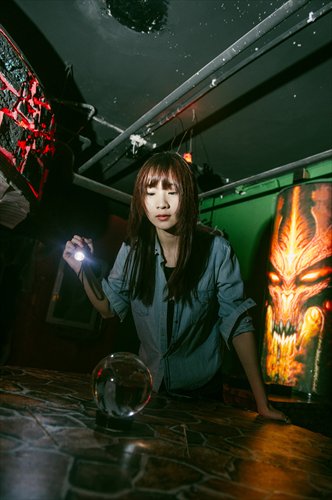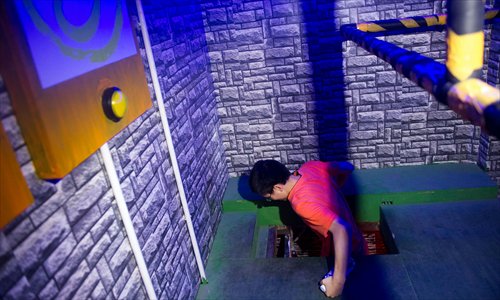Escape room 2.0
Beijing’s puzzle break games get high-tech makeover

Automation technology has become a highlight of escape entertainment. Photo: Li Hao/GT
When Zhao Yanfang, 26, and her three friends stepped into the dark, quiet room, it suddenly lit up and a video on the wall began to broadcast a message. "This is the Sky Net System. An intruder has been detected, and the whole area is now locked up," said a computerized female voice. "A deadly virus will be released. Please input an identification code to get immunity against the virus."
Then the lights on the walls began to flicker, an alarm rang, and a clock began to tick down the minutes, while on the screen several lines of strange patterns, numbers and letters appeared, indicating the code.
Zhao and her friends felt a little panicked, but still quickly rushed to the screen and tried to decode the password.
Zhao and her friends were not four ordinary white collar workers living in Beijing that day, but a team of special agents trying to save the Earth from an evil organization who developed a system called Sky Net.
The system hacked into the nuclear weapon systems of some major countries in the world and planned to trigger all of the nuclear bombs at one time and destroy the world. Zhao and her friends were going to destroy the Sky Net System before this could happen. This was the alternative reality presented by the escape room.
Since 2012, there have been many escape rooms established in Beijing. Players pay to be locked in a room and find clues and hints to the keys to the exit. Recently, these games have evolved with the development of technology.
Now, more scientific, electrical and mechanical elements are included, making escaping more thrilling for participants.
"It was so cool," Zhao said when she finished the room escape called "The Last of Us."
"I have never been to a place as cool as that. I can only say that science and technology is everywhere now in our daily lives, and it is fun."


Large-scale mechanisms are now common among Beijing's escape rooms. Photos: Li Hao/GT
Experience the fictional world
Differing from other escape rooms featuring locks and puzzles, Starroom in Chaoyang district, the escape room Zhao and her friends went to, did not have any physical lock and key or difficult riddles requiring hard thinking.
In Starroom, the players simply follow orders sent to them through an electric terminal and experience an appeal to the senses through lighting effects, music, and storytelling to complete their mission.
"The traditional way of finding a key in the room to the door of the next room is boring," Zhao said.
"I love the experience of following instructions and trying novel ways of opening a door."
During their time as superheroes that day, Zhao and her friends opened a door by touching different areas of the door to input a password and another door by pointing a laser at an area, and both activities were accompanied by sound effects.
"We consider science and technology to be our most prominent characteristic," manager of Starroom Zhou Di said.
"We like science fiction movies and video games, and what we are doing is creating a real scene in a fictional world."
Zhou and his team designed and built the 300-square-meter space themselves in 2014, and they are constantly improving upon it.
Most of their inspiration comes from sci-fi blockbusters like Doom (2015), Resident Evil (2002), Silent Hill (2006) and Interstellar (2014).
Most of the mechanisms are controlled by Wi-fi signal receivers, Zhou said. When the players use the right codes, the receivers catch their moves and send signals to the mechanisms they control, triggering the reaction of the system.
However, the most unique aspect of Zhou's escape room is the original app his group developed. Before players go into the room, each of them will have an iTouch that has been installed with the app. Players use these to scan QR codes to get hints to puzzles.
Additionally, the app can also serve as a virtual health indicator for each player. Under certain conditions, the players may get attacked by a virtual virus and their health data represented on the app drops every other minute until they find hidden QR codes around the room that supply health. When a player's health indicator drops to zero, the player "dies," but players can bring them back to life by inputting the hidden codes in the player's iTouch through the app.
"The app still needs to be improved, and in the future it will be more complicated," Zhou said.
Mechanical links
While the development of Beijing's escape rooms is bringing technology into entertainment, another kind of escape room featuring large-scale mechanisms is also becoming popular.
While slowly rotating a deer head statue, Guo Yishuai, a university student, and her three classmates, all girls, screamed together as the skeletons set in the walls behind them began to make "creepy" sounds and their eyes started to glow red.
However, the more frightening aspect of this was that the wall full of skeletons had begun to slowly move toward them and looked like it was going to crush them.
"We were too scared to continue," Guo said. "We all rushed out of the room screaming and watched the wall get closer and closer to where we were standing."
Actually, Guo and her classmates should have stayed inside and worked on the mechanical puzzle located on another wall in the room.
If the five, heart-shaped rotating knobs would have been turned to the right position according to the clues they found in the previous room, the moving wall would have stopped and another door would have opened automatically.
Such big-scale mechanisms are common in Beijing's escape rooms, including Jixie Micheng, an underground escape room covering more than 300 square meters in Xicheng district.
"The mechanism behind the moving wall is a large electric-powered track," said Wang Xiaofeng, 39, a professional designer of escape rooms who has been in charge of designing many escape rooms in Beijing, including Jixie Micheng, Hex and Baozou Mushi, all large-scale escape rooms featuring many moving mechanisms.
Wang said the process of the game is controlled by the computer system they designed. When the triggering signal is detected by the system - for example, if the player turns over a statue - the sound and light effects, as well as the moving wall, are activated.
"Modern mechanical displays involve a lot of systems, including electronics, sensors, automation technology, and also an integration of artistic design, film set design, and scriptwriting," Wang said. "It is a comprehensive industry, and it's really fun."
Once Wang and his team designed a Terracotta Warriors and mausoleum of the first Qin emperor mechanism, which was one of the most complicated he had ever done.
"I set several terracotta warriors in the room and attached signal receivers at the bottom of each statue, and only if every single warrior is rotated to the right direction can the signal be sent to the control system, thus an order of opening a door is sent to the mechanism," Wang said.
"At the same time the mechanism controls the light effects of the 'underground palace,' which are rather exciting and interesting visual effects, but also ones that present more difficulties for our designers."
Future development
According to Wang, who began his career as an escape room designer in 2012, the evolution of Beijing's escape rooms is happening very fast.
"In the future, the traditional ones that focus on difficult puzzles done by hand will be gradually eliminated, and technology will play an increasingly important part in escape room design," Wang said. "A qualified escape room is like a role-playing game, or an action-suspense movie."
Zhou agrees with Wang. His team is opening two more branches of Starroom in Beijing this month and expanding one theme to seven.
"Our future efforts will be mainly on app development and the interaction between apps and real room escape games," Zhou said. "The integration of virtual gaming and escape room design is also important."